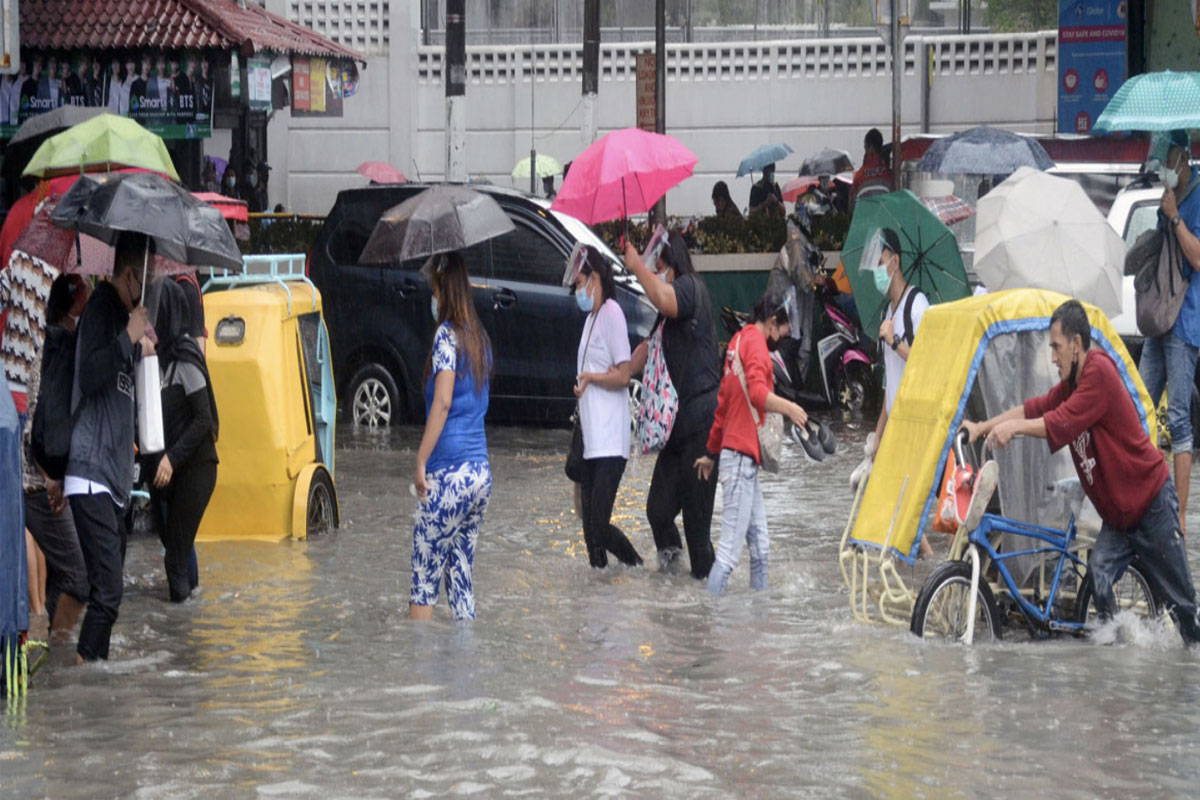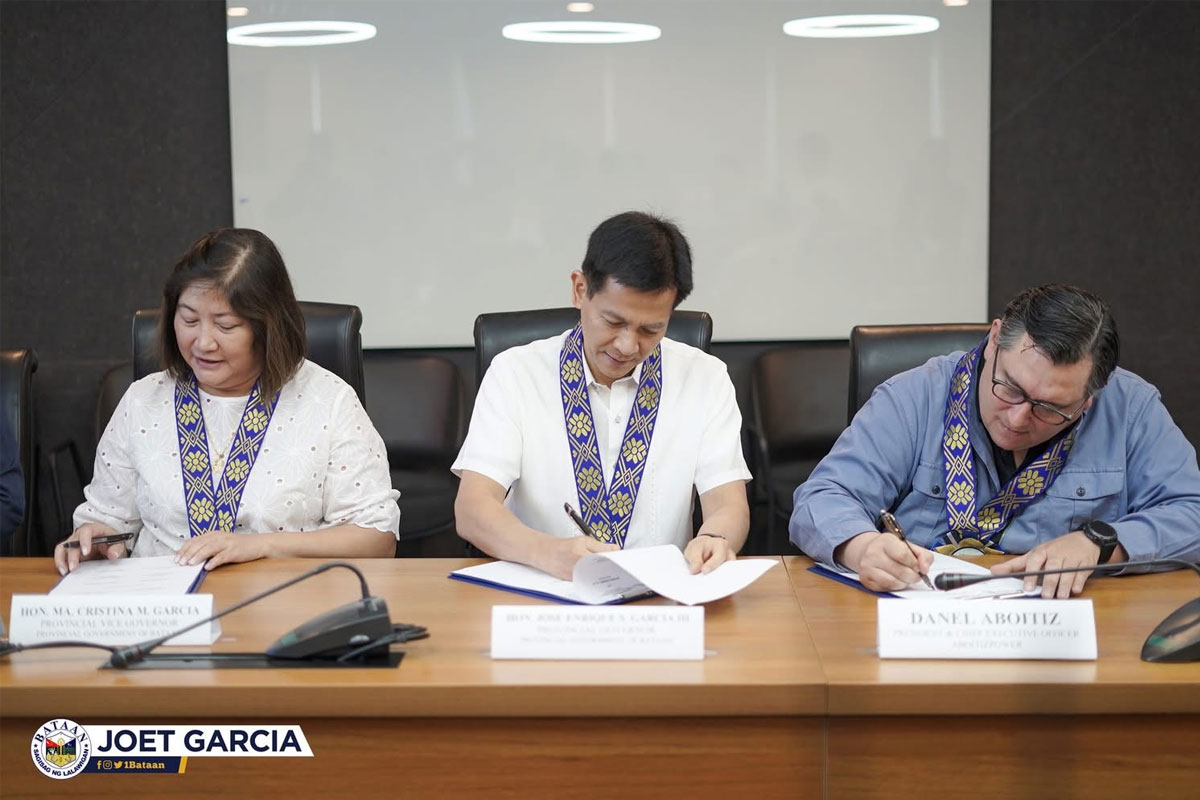 FLOODS–Residents walk in a flooded portion of a street in Manila. The worsening floods have prompted CamSur Rep. Lray Villafuerte to compel all LGUs in the country to have rainwater facilities to pool rainwaters instead of just spilling in the streets. Photo by Jon Jon Reyes
FLOODS–Residents walk in a flooded portion of a street in Manila. The worsening floods have prompted CamSur Rep. Lray Villafuerte to compel all LGUs in the country to have rainwater facilities to pool rainwaters instead of just spilling in the streets. Photo by Jon Jon Reyes
Retan rainwater, LGUs encouraged
IN light of the paradox of water supply shortfalls and flash floods of increasing frequency and intensity especially in Metro Manila and cities outside the capital as a result of climate change, Camarines Sur Rep. LRay Villafuerte saids Thursday he believes Congress can help address such twin woes by empowering local government units (LGUs) to compel commercial, institutional and residential estate developers to install rainwater retention facilities within their projects.
Villafuerte, president of the National Unity Party (NUP) and a former Camarines Sur governor, has proposed in a bill authorizing LGUs to make “the installation of rainwater retention facilities in all new commercial, institutional, and residential infrastructure projects in Metro Manila and other major cities” as a prerequisite for their issuance of construction permits to property developers.
For ongoing commercial, residential and institutional projects whose approved designs have no such rainwater retention facilities, Villafuerte’s proposal has a provision requiring the developers of these construction projects to build them within three years if and when this becomes law—or face penalties for every year of non-compliance.
Villafuerte said the government should also invest in small water-impounding facilities and pumps to help communities retain rainwater for their water needs.
The former CamSur governor said the urgency for collecting rainwater that would otherwise just flood the National Capital Region (NCR) and other urban centers is best illustrated by the fact that despite the 20-meter rise in the water elevation of Angat Dam and the spillover levels at Ipo Dam and La Mesa Dam following the recent onslaught of typhoons Egay and Falcon, the Maynilad Water Services Inc. (MWSI) is poised to resume its suspended water supply interruptions affecting 500,000 to 600,000 households in its concession area.
Maynilad president-CEO Ramoncito Fernandez reported earlier this week at a forum that the water interruptions are necessary because, notwithstanding the higher Angat Dam water elevation, the National Water Resources Board (NWRB) has yet to adjust its water allocations for Maynilad and Manila Water Co. in anticipation of the El Niño or long dry spell phenomenon.
Last July, the low water elevation of Angat Dam prompted the Maynilad to carry out daily water supply interruptions that affected 591,000 household-consumers in its Metro Manila west zone concession area, but it subsequently cut short the rationing as the dam’s water level went up following the heavy rains.
As of last weekend, the PAGASA said the water level of Angat Dam rose by 20 meters to 198.99 meters—above its minimum operational threshold of 180 meters—because of typhoons Egay and Falcon and the southwest monsoon or habagat.
However, NWRB Executive Director Sevillo David said that although reaching its “normal operating level,” Angat Dam has yet to hit its “normal high level” of 210 to 212 meters to meet the water needs of NCR till next year’s dry season amid the El Nino threat.
The dam’s water elevation was only 178 meters in mid-July.
David said that five provinces, including CamSur, received above-normal rainfall in July.
To conserve potable water, HB 5640 states that rainwater collected by a harvesting facility may be used for non-potable and suitable purposes, such as gardening and air-cooling processes.
Villafuerte said the passage of HB 5640 has become even more appropriate as the government braces for the onslaught of another El Niño or long dry spell, which the PAGASA expects to hit the Pacific this semester and possibly persist till 2024.
HB 5640’s Section 5 on “design approval” states that “the provision for a rainwater harvesting facility shall be required by the Housing and Land Use Regulatory Board (HLURB) and LGUs to be incorporated into the design of all new commercial, institutional and residential development projects in Metro Manila and other major cities, and no project design shall be approved for construction unless it includes such facility.”
This section further directs the HLURB and the LGUs to ensure that these facilities are built during the construction phase of the projects.
Villafuerte lamented that despite the incessant flooding of major thoroughfares in urban centers resulting to heavy traffic, the government has failed to come up with adequate measures to address the situation.
“Metro Manila is annually drenched with some 20,000 millimeters of rainwater,” he said.
“A significant part of NCR and other major cities are unable to absorb the rainwater they receive. Instead of undergoing the earth’s natural process of recycling rainwater through its aquifers, the rainwater proceeds to the sewers—polluting the surrounding bodies of water and flooding roads.”
He noted in the bill that Cebu, Baguio and Nueva Ecija have already adapted similar measures to utilize rainwater for non-potable uses; and that overseas, the state of California passed its own Rainwater Capture Act in 2012, while in Australia, most buildings use captured rainwater for fountains and for flushing toilets.
Section 4 of this bill states that any owner or developer of a new commercial, institutional or residential development project in Metro Manila and other major cities, with an area of at least 1,500 square meters (sq m) shall “reserve, develop and maintain at least 3% of the total area, exclusive roads, service streets and alleys, as a rainwater harvesting facility.”
The owners or developers of ongoing commercial, institutional or residential development project in Metro Manila and other major cities that have no existing provision for rainwater facilities “shall build the facility within a period of 3 years from the effectivity of this Act, or suffer the penalty imposed in Section 9” of this bill, adds HB 5640.
Within 60 days from the effectivity of this Act, HB 5640 mandates the DPWH Secretary to craft the implementing rules and regulations (IRR), in coordination with the Secretary of the Department of Interior and Local Government (DILG), Chief Executive Officer (CEO) of the HLURB, and Administrator of PAGASA.
The IRR shall include the standards and guidelines for the design, construction, installation, materials, site selection and planning, site-specific considerations, and maintenance of the rainwater harvesting facilities.
Rainwater harvesting facilities must be designed to cope with a pre-determined flood and rain return period and must have a storage capacity prescribed by the Department of Public Works and Highways (DPWH), and the design of the rainwater harvesting facility shall include the following:
• Size, shape and physical characteristics of available space;
• Construction plans with specified material type including lining and coating requirements;
• Detailed drawing on how the installation will drain into an outfall structure as a dry well or a percolation chamber, storm drain system, drainage channel, or natural wash; and
• Mechanism to exclude mosquitoes and not permit mosquito production.
Section 7 on building permits requires that if the design of a new commercial, institutional or residential project with an area of at least 1,500 sq m does not provide for a rainwater harvesting facility, “the LGU concerned shall deny the request for issuance of a building permit for such a project.”
Moreover, the DPWH is mandated to require owners or developers of all of all new commercial, institutional or residential development projects covered under HB 5640 to submit a compliance report within 12 months from the date of the completion of their respective projects.
Also, the DPWH shall require building owners to submit annual reports of the performance of their respective rainwater retention facilities, which may include information on the total volume of retained rainwater and utilization.

















